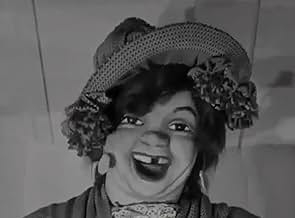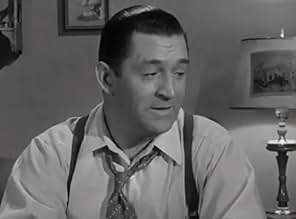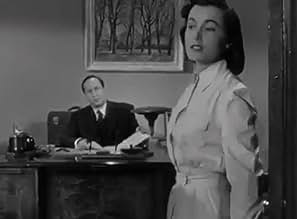CALIFICACIÓN DE IMDb
6.2/10
899
TU CALIFICACIÓN
Agrega una trama en tu idiomaMany interested parties are after the loot from a factory payroll heist but the mobster who hid it has amnesia after undergoing experimental brain surgery in the prison hospital.Many interested parties are after the loot from a factory payroll heist but the mobster who hid it has amnesia after undergoing experimental brain surgery in the prison hospital.Many interested parties are after the loot from a factory payroll heist but the mobster who hid it has amnesia after undergoing experimental brain surgery in the prison hospital.
- Dirección
- Guionistas
- Elenco
Chris Alcaide
- Pursuing Detective
- (sin créditos)
Fred Aldrich
- Cop
- (sin créditos)
Leonard Bremen
- Guard at Clinic
- (sin créditos)
Paul Bryar
- Freddie - Bartender
- (sin créditos)
Sayre Dearing
- Patient in Wheelchair at Clinic
- (sin créditos)
Frank Fenton
- Detective Driver
- (sin créditos)
John Harmon
- Herman
- (sin créditos)
Mary Alan Hokanson
- Nurse
- (sin créditos)
Shepard Menken
- Interne
- (sin créditos)
Howard Negley
- Detective
- (sin créditos)
Frank O'Connor
- Gate Guard
- (sin créditos)
Opiniones destacadas
Edmond O'Brien stars in "Man in the Dark," a 1953 film also starring Audrey Totter. O'Brien plays Steve Rawley, a prisoner who undergoes experimental surgery that's supposed to erase the criminal elements of his brain. It also wipes his memory of past events.
Unfortunately Steve and some other thugs committed a big robbery and Steve hid the money. Now that he has no memory, he doesn't know where he put it. His old gang kidnaps him and tries to find out his hiding place. His old girlfriend Peg (Totter) is around, and she wants him to forget the whole thing and go away with her.
Steve starts remembering things in the form of bizarre dreams. He and Peg attempt to follow the clues in the dreams to track down the money.
Edmond O'Brien made a lot of these B films for Columbia. This one is no better or worse than many of them. The last part of the film takes place in an amusement park, and it's very good.
Originally this film was in 3-D, and like some other films, it was filmed in the seen-better-days area of Ocean Park near Venice, CA. I always like seeing the old LA, and this film has lots of shots of it.
I had one major problem with this film, and it's a major plot hole. If you had stolen a lot of money and hidden it, why would you agree to a surgery that is going to clean out your memory so that you don't remember where you hid it?
I don't know the answer.
Unfortunately Steve and some other thugs committed a big robbery and Steve hid the money. Now that he has no memory, he doesn't know where he put it. His old gang kidnaps him and tries to find out his hiding place. His old girlfriend Peg (Totter) is around, and she wants him to forget the whole thing and go away with her.
Steve starts remembering things in the form of bizarre dreams. He and Peg attempt to follow the clues in the dreams to track down the money.
Edmond O'Brien made a lot of these B films for Columbia. This one is no better or worse than many of them. The last part of the film takes place in an amusement park, and it's very good.
Originally this film was in 3-D, and like some other films, it was filmed in the seen-better-days area of Ocean Park near Venice, CA. I always like seeing the old LA, and this film has lots of shots of it.
I had one major problem with this film, and it's a major plot hole. If you had stolen a lot of money and hidden it, why would you agree to a surgery that is going to clean out your memory so that you don't remember where you hid it?
I don't know the answer.
Edmond O'Brien has a severe case of retrograde amnesia, but he didn't contract it in the Pacific. He's a robber who got away with $130,000 in a Christmas Eve heist, was convicted and served his time. But he'll get a second chance if he submits to an operation to excise the criminal portion of his brain. Understandably, he's conflicted, and when they move it up from the scheduled day he balks: `I was born on a Monday. I may as well go on one like dirty laundry.' But the operation proves a stunning success, so delicate that it erases all memories of his past life but leaves him with a perfect command of American slang.
But the placid life he leads at the sanitarium pruning hedges and daubing canvases comes to an abrupt halt when he's kidnaped by his old gang, now led by Ted De Corsia. They want the money, which was never recovered; so does an implacable Javert of an insurance investigator. Even his old girlfriend (Audrey Totter) sees him only as a ticket to the high life, until she falls for the new, improved O'Brien and renounces her grasping ways. (The often ill-used Totter shines here, especially on a martini bender when she asks the bartender, `Oh, Fred, what do you do when you hate yourself?')
Odd clues begin to surface from O'Brien's troubled nightmares, however, leading him and Totter (with the rest of the cast plus the police in pursuit) to claim a parcel left at an amusement park. And this is the big set-piece of the movie, originally released in 3-D. Cars come whooshing around the curves and down the dips of a roller coaster while pitched battles are being fought on the tracks. Watching these 3-D movies now is like drinking soda that's gone flat: All the ingredients are there but the sparkle's gone. But in their endearingly gimmicky way, they evoke their era, as do the flats equipped with party lines and furnished with lampshades bearing reproductions of paintings. Man in the Dark's too short, and needs an extra layer of complexity. But there's still a bit of fizz left in it.
But the placid life he leads at the sanitarium pruning hedges and daubing canvases comes to an abrupt halt when he's kidnaped by his old gang, now led by Ted De Corsia. They want the money, which was never recovered; so does an implacable Javert of an insurance investigator. Even his old girlfriend (Audrey Totter) sees him only as a ticket to the high life, until she falls for the new, improved O'Brien and renounces her grasping ways. (The often ill-used Totter shines here, especially on a martini bender when she asks the bartender, `Oh, Fred, what do you do when you hate yourself?')
Odd clues begin to surface from O'Brien's troubled nightmares, however, leading him and Totter (with the rest of the cast plus the police in pursuit) to claim a parcel left at an amusement park. And this is the big set-piece of the movie, originally released in 3-D. Cars come whooshing around the curves and down the dips of a roller coaster while pitched battles are being fought on the tracks. Watching these 3-D movies now is like drinking soda that's gone flat: All the ingredients are there but the sparkle's gone. But in their endearingly gimmicky way, they evoke their era, as do the flats equipped with party lines and furnished with lampshades bearing reproductions of paintings. Man in the Dark's too short, and needs an extra layer of complexity. But there's still a bit of fizz left in it.
Edmond O'Brien played in quite a few film noir pictures. And, interestingly, they all seem to be excellent...even "Man in the Dark" which you would expect to be a bad picture even WITH O'Brien. Why? Because the film was cranked out in only 11 days AND because there were a lot of cheap 3D tricks in the picture...yet it still turned out to be very, very good. So why would the studio do this in 11 days? Apparently, 3D movies were brand new and they wanted to be the first major studio to make a 3D picture....yet, amazingly, the film doesn't seem rushed or second-rate!
When the story begins, a prisoner (O'Brien) is about to undergo some surgery. When he awakens, he has no memory of who he was and is christened 'Steve Rawley' by the doctors. Unfortunately, his old gang doesn't know about the purpose of the surgery--they just know they've got to kidnap him and tell them where he stashed the loot from a robbery. But he really does NOT know where it is nor who he was. His only clues are strange dreams he's been having. Could they point him to the right direction before the gang decides just to kill him and be done with it?
As usual, Edmond O'Brien is great. He's tough, mouthy and just the sort of ugly mug you'd expect in a noir picture. And, having Audrey Totter and Ted de Corsia in supporting roles sure didn't hurt! Overall, a nice viewing experience...even with all the 3D gimmicks and use of rear projection towards the end (which I normally hate because it looks so fake).
When the story begins, a prisoner (O'Brien) is about to undergo some surgery. When he awakens, he has no memory of who he was and is christened 'Steve Rawley' by the doctors. Unfortunately, his old gang doesn't know about the purpose of the surgery--they just know they've got to kidnap him and tell them where he stashed the loot from a robbery. But he really does NOT know where it is nor who he was. His only clues are strange dreams he's been having. Could they point him to the right direction before the gang decides just to kill him and be done with it?
As usual, Edmond O'Brien is great. He's tough, mouthy and just the sort of ugly mug you'd expect in a noir picture. And, having Audrey Totter and Ted de Corsia in supporting roles sure didn't hurt! Overall, a nice viewing experience...even with all the 3D gimmicks and use of rear projection towards the end (which I normally hate because it looks so fake).
Edmond O'Brien plays a criminal who is paroled to participate in experimental brain surgery which will remove his criminal impulses as well as his memory. The problem is that his former partners want their shares of $130,000 he stole before he went to jail. (Big Plot problem: Why would O'Brien agree to participate in this experiment if he knew he had a bundle waiting for him? Wouldn't he just do his time?) This B-crime drama, too light in tone to qualify as a Film-noir (check out O'Brien in DOA if you want to see some real Film Noir), with its paper-thin characterizations and dated tough guy dialog, would be easily forgotten if not for its status as the first Big Studio picture released in 3-D. Check it out: It beat "House of Wax" to the screens by one day. I just had the good fortune to see an excellent print of the film today at the Maryland Film Festival. (I should say prints, since it was projected by two cameras simultaneously.) The 3-D experience more than compensated for any deficiencies in the script. (In the film's defense, it does move along quite quickly in its effort to entertain.) I have seen many of the classic 3-D films in their natural format, and I found the 3-D in this film fabulous. Just seeing the black & white Columbia logo itself was worth the price of admission. Oddly, however, the intentional 3-D effects, amusing as they could sometimes be, distracted from the overall 3-D experience. I found myself fascinated simply by the illusion of depth in simple conversational scenes with the occasional object in the foreground. If I were flipping through the channels and watched a bit of this film flat on television, I doubt I would linger very long on it, but the excellent 3-D made it a worthwhile theatrical experience. Check it out if you ever get the chance.
Originally made in 3-D, this is another of Columbia's black & white releases of this genre (like Vincent Price in the Mad Magician). 3-D process and numerous subjective camera techniques (like scapels used in operation coming out at the screen, bullets firing at speeding cars, whirling around car rides at an amusement park, etc.)make this interesting viewing and out of the ordinary story about a thug who can't remember anything about his $130,000 heist after brain surgery.
¿Sabías que…?
- TriviaThe first 3-D feature ever released by a major American studio. Los crímenes del museo de cera (1953) went into production first, but Columbia rushed "Man in the Dark" - shooting it in a mere 11 days - to get it into theaters just days before "Wax" opened. (El diablo bwana (1952) preceded both of them, but United Artists was not considered a major studio in the early 1950s.)
- ErroresDuring the chase when Steve is abducted, one of the crooks leans out of the car and fires nine shots at the cops from a six-shot revolver.
- Citas
[first lines]
Cop: You get prettier every day.
Nurse Receptionist: Tell me about the beauty contest you won.
- Versiones alternativasOriginally released in 3D, in prints that were sepia-toned.
- ConexionesFeatured in TJ and the All Night Theatre: The Man Who Lived Twice (1979)
Selecciones populares
Inicia sesión para calificar y agrega a la lista de videos para obtener recomendaciones personalizadas
Detalles
- Tiempo de ejecución1 hora 10 minutos
- Relación de aspecto
- 1.37 : 1
Contribuir a esta página
Sugiere una edición o agrega el contenido que falta

Principales brechas de datos
By what name was El hombre en las tinieblas (1953) officially released in India in English?
Responda


































